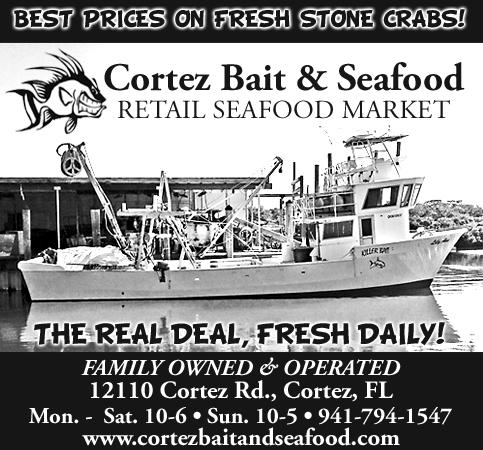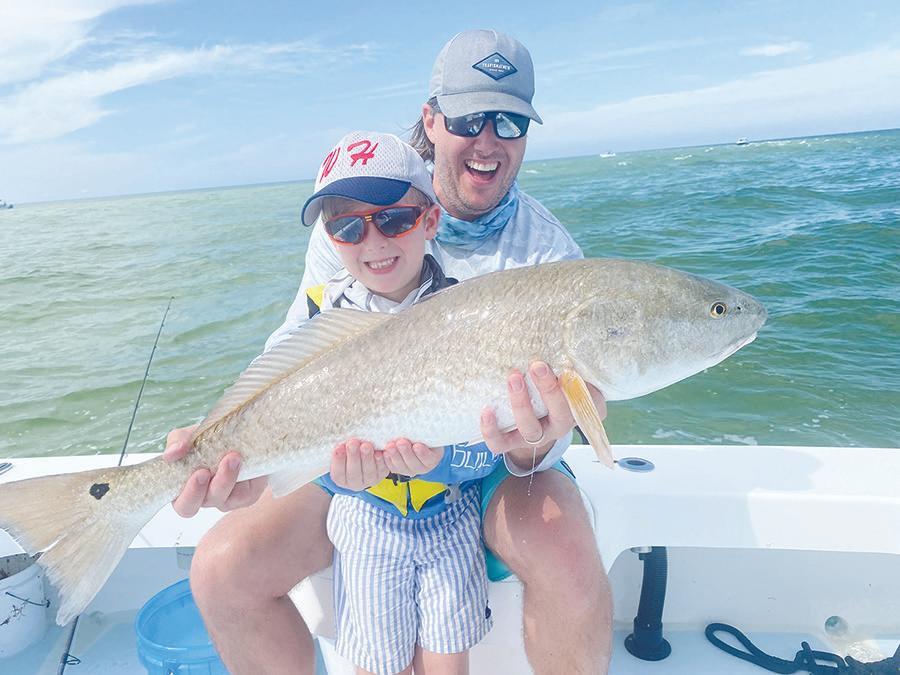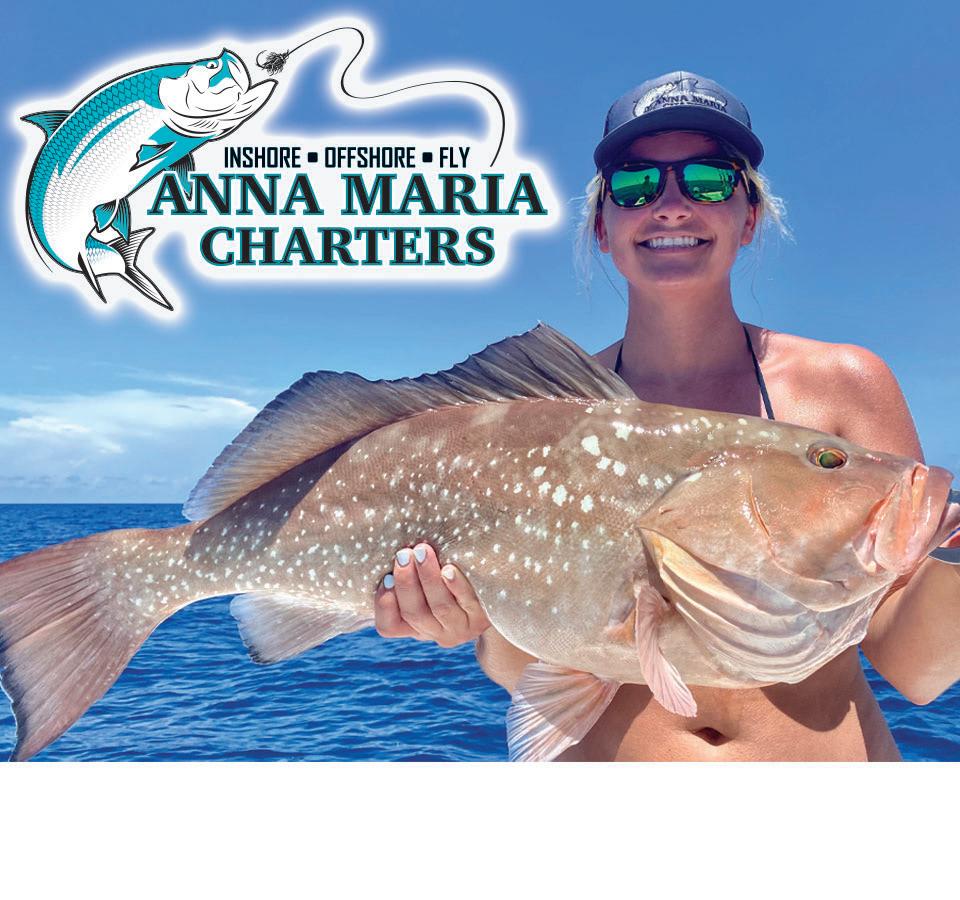
7 minute read
OUTDOORS
NOVEMBER 10, 2021 OUTDOORS THE SUN 17
Anatomy of a fishing rod
Reel Time
RUSTY CHINNIS
Whatever rod you fish with, be it a spinning rod, a fly rod or a casting rod, they all share the basic components - blank, guides, reel seats and handles. So why is one rod more expensive than another?
A rod’s blank is constructed from a product known as prepreg. This material is impregnated with resin and wrapped around a mandrel (which is removed after the blank is formed) giving the rod its basic round shape. This “blank” holds the guides, ferrules, handle, reel seat and fighting butt.
Prepreg has fibers that have a unidirectional (straight) orientation. The fibers can be made of different materials including fiberglass, graphite, boron or Kevlar. Some rods are made (laid up) from a prepreg that has additional fibers that run around or at an angle to the unidirectional fibers. This gives the rod additional strength and influences flex, stiffness and price.
A rod’s scrim refers to a lightweight material that forms an additional lining under the primary fibers and helps in working the material when it is wrapped around the mandrel. Scrim can be straight or woven and adds what is known as “hoop strength” to the finished rod.
The butt section is the cork part of the rod behind the reel seat that is held either in the non-dominant hand or fits into a fighting harness when playing a fish, while the handle is where the dominant hand is placed. The reel seat secures the reel to the rod. The fixed hood is the metal receiver where one end of the reel foot is placed. The sliding hood is the rear receiver that holds the other end of the reel foot. The locking ring is a nut that puts pressure on the sliding hood and holds the reel securely in place. The guides hold the line along the length of the blank. The ferrules connect sections of a two- or four-piece rod. The tip, as the name implies, is the section at the top of the rod.
You may also encounter the term taper. A rod’s taper refers to the diameter of a rod from the butt to the tip. The taper affects the rod’s action. Most rods have either a fast action (stiff) or a slow action (flexible).
When you’re shopping for a new outfit, knowing the parts and construction of a rod will help you make an informed decision. The most important part of the rod, and the one that most affects its price and your buying decision, is the blank. The materials and the method of construction of the blank determine its price. The least expensive rods are made from fiberglass while the expensive ones are constructed with graphite, boron and Kevlar. While fiberglass may be good for a beginner, the more expensive rods are a better choice for the seasoned angler. They are lighter, more responsive and less prone to break. But don’t let price determine your selection. There are a lot of very good rods on the market today that can be purchased at a good price point. The one thing to avoid is cheap equipment. It’s OK to buy a lower price point outfit if you’re a beginner, but choose an outfit that will make a good second rod when you upgrade. An informed decision can positively affect your angling efficiency and enjoyment.

Rod choice becomes critical when choosing an outfit for demanding conditions
RUSTY CHINNIS | SUN











Expect major fishing changes as weather cools
CAPTAIN DAVE WHITE
What a cold front we’ve had this last week! With these drastic changes in temperature, look for some major changes in the weeks ahead. Inshore, we can expect to see an influx of sheepshead, black drum, pompano, hogfish, bluefish, and of course, kingfish. The redfish will still remain strong, but the snook and snapper fishing may slow down a bit.
We will start to gear up for more shrimp fishing. We will still use pilchards, but the winter belongs to the shrimp-eaters.
Offshore, amberjack move in a bit closer in the colder months, as do the blackfin tuna. Kingfish will be very near to the beach as long as water quality and the threadfin are good. We will still be targeting mangrove and yellowtail snapper, but probably won’t get the numbers we accomplished in summertime.
No matter what the weather is, we always have something to target and welcome the change.
CAPTAIN RICK GRASSETT
Anglers fishing with me, out of CB’s Saltwater Outfitters on Siesta Key, had some action catching and releasing trout, blues, Spanish mackerel, jacks and tripletail on flies and DOA Lures recently. Pat Beckwith, from Sarasota, fished Sarasota Bay with me and had some action catching and releasing trout to more than 20”, plus blues and Spanish mackerel on Clouser flies. I did some scouting one day with my friend, Steve Gibson, of Southern Drawl Kayak Fishing. With good conditions, we hunted tripletail, found a few, and Steve caught and released several on flies. Mostly small but still wary and a fun sight-fishing option. Marshall Dinerman, from Lido, and Mike Kreisberg, from Longboat Key, also fished Sarasota Bay with me and caught and released numerous trout, jacks and a juvenile cobia on CAL jigs with a variety of tails.
Look for reds, snook and large trout in shallow water. Fishing deep grass flats of Sarasota Bay is a good choice for action with a variety of species including trout, Spanish mackerel, jacks, blues and more. Our natural resources are under constant pressure from red tides fueled by industrial, agricultural and residential runoff, toxic spills and discharges, freezes, increasing fishing pressure and habitat loss and degradation. Please limit your kill, don’t kill your limit!

CAPTAIN DAVE WHITE | SUBMITTED Patrick Davis, and his son, Bear, show off a good redfish caught with Captain David White of Anna Maria Charters.
Manatees on the move
November is Manatee Awareness Month and the Florida Fish and Wildlife Conservation Commission (FWC) is reminding boaters to slow down and look out for migrating manatees this time of year.
As water temperatures cool this season, manatees are migrating to warmer waters around the state in springs and near power plant outflows, causing them to spend more time in high-traffic boating areas.
This year, it’s especially important to be vigilant, as an unusual manatee mortality event continues on Florida’s east coast in the Indian River.
Manatee protection zones are marked by waterway signs; maps of manatee protection zones are available online at MyFWC.com/Manatee by clicking on “Data and Maps.” slow-speed zones. • Wear polarized sunglasses to see manatees in your path. • Keep a lookout for the circular “footprints” or ripples they leave on the surface of the water. • If you observe a manatee mating herd - several manatees gathering as males vie to mate with a female - watch from at least 100 feet away. Coming any closer might disrupt the mating or endanger you; adult manatees typically weigh more than 1,000 pounds. • Never feed or water manatees as they will become habituated to people, which could put them at risk of injury. • Stow trash and line when underway. Marine debris that blows overboard can become ingested by or entangled around manatees. (3922), dial #FWC or *FWC on a cellphone or text Tip@MyFWC.com if: • you see a manatee with a pink or red (fresh) wound. • the manatee is tilting to one side, unable to submerge or seems to have trouble breathing. • you see a manatee calf by itself with no adults around for an extended period. • you see anyone harassing a manatee in any way. • you see boaters speeding in a protected area. • you see a manatee entangled in monofilament, crab-trap lines or other debris. • you see a dead manatee.
To support the FWC’s manatee research, rescue and management efforts, purchase a Florida manatee license plate or donate $5 to receive a collectible FWC manatee decal at a local Tax Collector’s office.








